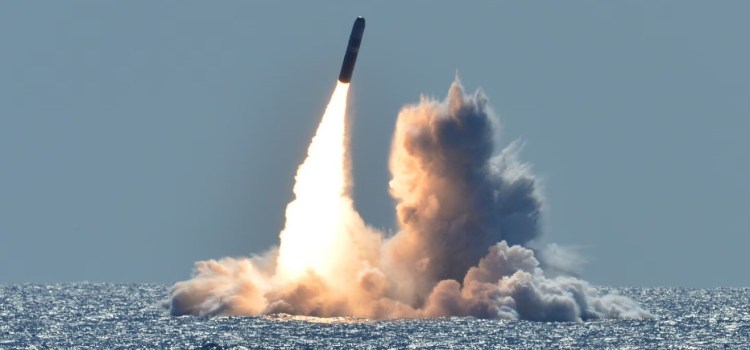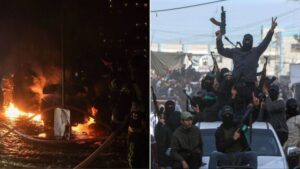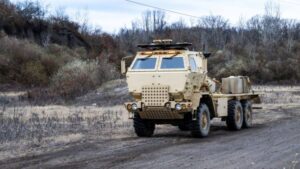The following article first appeared on Warrior Maven, a Military Content Group member website.
The Nobel Peace Prize gave their award this year to Nihon Hidankyo, representing the survivors of the nuclear bombing of Hiroshima and Nagasaki. The point was to emphasize that nuclear weapons should never be used again under any circumstances and must be abolished.US policy has been for decades that if required, the United States would reserve the right to use nuclear weapons in response to a conventional, biological, or chemical weapons attack on the United States and its allies.
For example, during the entirety of the Cold War, the United States did not match the Soviet armies tank for tank or artillery piece for artillery piece in central Europe. President Eisenhower understood such a large conventional force would bankrupt the United States.
While the US had 423,000 troops in Europe and Asia at the height of the Cold War, it was assumed that a Soviet tank army attack through the Fulda gap into Western Germany or a North Korean attack on the ROK or a PRC attack on Taiwan, might very well require the United State to respond with nuclear weapons. The US and its Pacific or NATO allied forces, while formidable, were not necessarily sufficient to hold the line.
This promise by the United States was called extended deterrence. Washington would extend its deterrent nuclear umbrella over the NATO allies in Europe and Western Pacific allies as a security guarantee. In this way, the Soviets could not swallow one NATO country after another because any attack on one NATO nation was considered an attack on the entire alliance. In the Pacific, an attack on a US ally would be considered an attack on the United States as well. With the collapse of the Soviet Union and the end of the Warsaw Pact, NATO remained and added a considerable number of nations that were previously allied with the Soviet Union. These nations did not want to remain in security limbo between a new Russia and an old NATO. These nations joined NATO to feel secure.
Now the CFE or Conventional Forces Europe treaty of November 1990 did confirm the most dramatic reduction in conventional forces in history, but the concerns of the former Soviet empire states were confirmed when in 2007 Russia suspended its participation in the treaty and in 2015 completely halted its participation and then withdrew from the treaty altogether in 2023. As a military force, NATO was relatively formidable but not postured to be an offensive factor in central European security. It literally posed no threat to Russia’s security. However, with Russia’s growing nuclear forces plans initiated in part by the 1999 Yeltsin decree calling for the development of battlefield nuclear weapons, and Mr. Putin at the helm, Russia came to be seen as a growing threat. With Moscow’s invasion of Moldova and Georgia in 2008 and Ukraine in 2014 and 2022, for most of Europe, the extended deterrent of the United States was deemed essential to protect their security.
The Biden administration did consider adopting a nuclear policy known as “No first use.” The theory was that if all nuclear armed nations pledge not to initiate the use of nuclear weapons, then nuclear weapons will remain deployed but never used, and in this way their salience as a security measure can be gradually reduced to where abolition becomes a real possibility.However, the US extended security guarantee to Europe was based on the United States explicit willingness to use nuclear weapons in retaliation to an attack, with the long-standing assumption that a nuclear conflict could very well grow out of a conventional conflict.This was also true for our extended guarantee we had traditionally provided for Japan and the Republic of Korea. Part of the guarantee was symbolized by the deployment of multiple thousands of small, regional, theater nuclear weapons, such as Tomahawk cruise missiles, deployed in both Europe and Asia.
The following article first appeared on Warrior Maven, a Military Content Group member website.
The Nobel Peace Prize gave their award this year to Nihon Hidankyo, representing the survivors of the nuclear bombing of Hiroshima and Nagasaki. The point was to emphasize that nuclear weapons should never be used again under any circumstances and must be abolished.US policy has been for decades that if required, the United States would reserve the right to use nuclear weapons in response to a conventional, biological, or chemical weapons attack on the United States and its allies.
For example, during the entirety of the Cold War, the United States did not match the Soviet armies tank for tank or artillery piece for artillery piece in central Europe. President Eisenhower understood such a large conventional force would bankrupt the United States.
While the US had 423,000 troops in Europe and Asia at the height of the Cold War, it was assumed that a Soviet tank army attack through the Fulda gap into Western Germany or a North Korean attack on the ROK or a PRC attack on Taiwan, might very well require the United State to respond with nuclear weapons. The US and its Pacific or NATO allied forces, while formidable, were not necessarily sufficient to hold the line.
This promise by the United States was called extended deterrence. Washington would extend its deterrent nuclear umbrella over the NATO allies in Europe and Western Pacific allies as a security guarantee. In this way, the Soviets could not swallow one NATO country after another because any attack on one NATO nation was considered an attack on the entire alliance. In the Pacific, an attack on a US ally would be considered an attack on the United States as well. With the collapse of the Soviet Union and the end of the Warsaw Pact, NATO remained and added a considerable number of nations that were previously allied with the Soviet Union. These nations did not want to remain in security limbo between a new Russia and an old NATO. These nations joined NATO to feel secure.
Now the CFE or Conventional Forces Europe treaty of November 1990 did confirm the most dramatic reduction in conventional forces in history, but the concerns of the former Soviet empire states were confirmed when in 2007 Russia suspended its participation in the treaty and in 2015 completely halted its participation and then withdrew from the treaty altogether in 2023. As a military force, NATO was relatively formidable but not postured to be an offensive factor in central European security. It literally posed no threat to Russia’s security. However, with Russia’s growing nuclear forces plans initiated in part by the 1999 Yeltsin decree calling for the development of battlefield nuclear weapons, and Mr. Putin at the helm, Russia came to be seen as a growing threat. With Moscow’s invasion of Moldova and Georgia in 2008 and Ukraine in 2014 and 2022, for most of Europe, the extended deterrent of the United States was deemed essential to protect their security.
The Biden administration did consider adopting a nuclear policy known as “No first use.” The theory was that if all nuclear armed nations pledge not to initiate the use of nuclear weapons, then nuclear weapons will remain deployed but never used, and in this way their salience as a security measure can be gradually reduced to where abolition becomes a real possibility.However, the US extended security guarantee to Europe was based on the United States explicit willingness to use nuclear weapons in retaliation to an attack, with the long-standing assumption that a nuclear conflict could very well grow out of a conventional conflict.This was also true for our extended guarantee we had traditionally provided for Japan and the Republic of Korea. Part of the guarantee was symbolized by the deployment of multiple thousands of small, regional, theater nuclear weapons, such as Tomahawk cruise missiles, deployed in both Europe and Asia.
In 1991, the United States proposed what was known as the PNI, or the Presidential NuclearInitiative where the United States unilaterally took down its thousands of regional or theaternuclear weapons, leaving a force of around 200 gravity bombs in Europe but completelyeliminating our regional or theater nuclear forces in Asia. The administration at the time wasassured by Moscow that Russia would follow suit and eliminate its multiple tens of thousands of such weapons as well.Today, the US intelligence community annually tells Congress that Moscow has some 1900 such deployed weapons, while independent experts such as Mark Schneider of NIPP and Chris Yeah of the University of Nebraska believe the Russians have upwards of at least 4000 such weapons.The Nobel Peace Prize Committee thinks nuclear weapons are wrong even for deterrence andreiterate the policy that nuclear weapons should never be used, a nuclear war should never be fought and a nuclear war cannot be won. This narrative sounds compassionate but it is strategic nonsense.If a nuclear deterrent is to be taken seriously, then the guarantor has to be serious about usingnuclear weapons in retaliation to an attack, whether conventional or nuclear. Otherwise, thedeterrent promise is pure bluff and cannot be taken seriously. After all, what is the point of asecurity guarantee if at the same time one openly declares an unwillingness to use suchweapons? The abolition community that supports no first use often describes such a policy asnuclear weapons being only for deterrence but not for “warfighting”….under the assumption that any use of nuclear force even in retaliation to a nuclear attack in the first place is “warfighting” and thus not a policy capable of achieving any objectives.This view has gained considerable support with the Oppenheimer movie and the Annie Jacobsonbook “On Nuclear War,” both of which have adopted the theme of abolition and a view that USdeterrent policy as adopted would automatically lead to all out nuclear Armageddon and thedeath of billions of people from nuclear winter.Not coincidentally just as the Nobel Peace Prize Committee awarded its annual prize, theChinese communist government again put forward its proposal that the nuclear powers of theworld should adopt a new declaration, pledging No First Use of nuclear weapons.
If adopted such a policy would help the CCP achieve its hegemon goals. For example, if the CCPattacked Tawan with cyber, space, EMP or conventional forces, any retaliatory strike would notinclude the use of nuclear weapons. Chinese forces would thus have a major advantage asattacking Taiwan would be in its own backyard would be in a nuclear sanctuary.When Japan said this past year that it would come to the defense of Taiwan, official Chinesepress sources declared that China would respond by destroying Japanese military capability “just as occurred in WW II,” along with demanding “unconditional surrender” an implicit pledge to use nuclear weapons against Japan, a nonnuclear state. And of course, engage in the first use of nuclear weapons in such a conflict.
What China (and Russia) are seeking is a world in which it is safe for the two nations to engagein conventional military aggression without having to worry that a nuclear response might beforthcoming. The No First Use pledge therefore is meaningless as Russia and China nucleardoctrine if examined carefully has myriad loopholes through which one could drive a heavilynuclear laden 18 wheeler!
The Nobel Committee has also inadvertently fallen into the political trap of implicitly blamingthe United States for the nuclear threats we see cascading in Asia and Europe. The UnitedStates’s extended deterrent– despite keeping the peace for the past 80 years (a point the Nobel folks acknowledge)— is now described as possibly leading to the use of nuclear weapons and thus the end of life on earth, to be remedied by the United States jettisoning its extended deterrent strategy that currently protects all of NATIO and its Pacific allies as well.And given the Nobel Committee’s assumption that nuclear weapons cannot be used and no such nuclear conflict can be won, what then is the need for such weapons? Given conventional, cyber, biological, chemical and EMP attacks no longer will trigger a possible nuclear response, and given that no one will now use nuclear weapons, (having pledged not to go first), cannot the United States logically safely embrace the unilateral elimination of its nuclear forces?What the Nobel Committee has helped set in motion—inadvertently–is the possible significant expansion of nuclear forces, especially with respect to Japan and the Republic of Korea as they both worry the United States’s extended deterrent is less than available. The new Prime Minister of Japan announced that Japan is seriously considering asking the United States to deploy nuclear forces in Japan or the region, a development parallel to growing support in the Republic of Korea for the same nuclear capability.
Now the origin of the growing nuclear threat to the Western Pacific is centered on China. AsTom Reed in his book “The Nuclear Express” detailed, China in 1982 secretly decided to helpspread nuclear weapons technology through Pakistan, (what became the Khan network), towhere nuclear weapons programs were initiated not only in Pakistan, but Libya, Iran and North Korea as well. In China’s view, having its friends brandish nuclear weapons would helpintimidate the United States and its Western Pacific allies, and eventually drive the US out of the region. At least that was the theory.
The United States has not adopted a No First Use policy although it was under considerationwhen the current administration originally took office. That factor alone has heightened theconcern among US allies that the nuclear extended guarantee of the United States is less thansolid. This in turn has led to a growing consideration of our allies to secure nuclear weaponsthemselves or bring such weapons into the region under the control of the United States.Now the opponents of extended deterrence will counter with more calls for arms control andnuclear deals with China, North Korea or Russia, and greater reliance on conventional forcesalone. But what if these rogue nations have no interest in reasonable measures to limit nuclearforces? And what if the United States is faced with a conventional conflict not “holding” becauseof an adversary introducing nuclear force?It is often claimed that a deal with North Korea was in the cards and should continue to bepursued. And that it was the unnecessarily harsh US reaction to discovering in 2002-3 that theDPRK was illegally enriching uranium that drove the North to develop and deploy nuclearweapons.But as Ollie Heinonen formerly with the IAEA in Vienna, Austria and a top nuclear expert on thematter explained recently, the North was developing nuclear weapons while participating in theSix Party Talks and the Agreed Framework, with the full intention of demonstrating such acapability when the bombs were developed. Which North Korea did in 2006, just as they plannedall along says Heinonen.The lesson? The United Sates is dealing with rogue regimes fully intent on using militaryaggression to serve their national purposes and drive the United States out of the Western Pacific,the Middle East and Europe. And as former Secretary of State Condi Rice has warned, strut theirstuff across the world stage as tyranny takes hold and democracy wanes. No First Use soundsnice, but as with most fortune cookie analysis, it has no substance. It is in fact dangerous.



